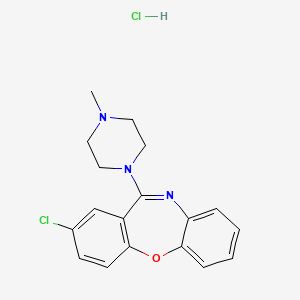



1. 2-chloro-11-(4-methyl-1-piperazinyl)-dibenz(b,f)(1,4)oxazepine
2. Cl 71,563
3. Cl-71,563
4. Cl71,563
5. Cloxazepine
6. Hydrochloride, Loxapine
7. Loxapine
8. Loxapine Monohydrochloride
9. Loxapine Succinate
10. Loxapinsuccinate
11. Loxipine Maleate
12. Loxipine Succinate
13. Loxitane
14. Maleate, Loxipine
15. Oxilapine
16. Succinate, Loxapine
1. Loxapine Hcl
2. Loxitane C
3. Loxitane Im
4. 54810-23-0
5. Loxapine (hydrochloride)
6. 376myl4mal
7. Desconex (tn)
8. Loxapine Monohydrochloride
9. Unii-376myl4mal
10. 2-chloro-11-(4-methyl-1-piperazinyl)dibenz(b,f)(1,4)oxazepine Monohydrochloride
11. Schembl41625
12. Chembl1201060
13. Dtxsid70203304
14. Hy-17390b
15. Loxapine Hydrochloride [vandf]
16. Loxapine Hydrochloride [mart.]
17. Loxapine Hydrochloride [who-dd]
18. Dibenz(b,f)(1,4)oxazepine, 2-chloro-11-(4-methyl-1-piperazinyl)-, Monohydrochloride
19. Loxapine Hydrochloride [orange Book]
20. Cs-0031021
21. Ft-0670868
22. D08148
23. Q27256644
24. 8-chloro-6-(4-methylpiperazin-1-yl)benzo[b][1,4]benzoxazepine;hydrochloride
| Molecular Weight | 364.3 g/mol |
|---|---|
| Molecular Formula | C18H19Cl2N3O |
| Hydrogen Bond Donor Count | 1 |
| Hydrogen Bond Acceptor Count | 3 |
| Rotatable Bond Count | 1 |
| Exact Mass | 363.0905176 g/mol |
| Monoisotopic Mass | 363.0905176 g/mol |
| Topological Polar Surface Area | 28.1 Ų |
| Heavy Atom Count | 24 |
| Formal Charge | 0 |
| Complexity | 450 |
| Isotope Atom Count | 0 |
| Defined Atom Stereocenter Count | 0 |
| Undefined Atom Stereocenter Count | 0 |
| Defined Bond Stereocenter Count | 0 |
| Undefined Bond Stereocenter Count | 0 |
| Covalently Bonded Unit Count | 2 |
Antipsychotic Agents
Agents that control agitated psychotic behavior, alleviate acute psychotic states, reduce psychotic symptoms, and exert a quieting effect. They are used in SCHIZOPHRENIA; senile dementia; transient psychosis following surgery; or MYOCARDIAL INFARCTION; etc. These drugs are often referred to as neuroleptics alluding to the tendency to produce neurological side effects, but not all antipsychotics are likely to produce such effects. Many of these drugs may also be effective against nausea, emesis, and pruritus. (See all compounds classified as Antipsychotic Agents.)
Dopamine Antagonists
Drugs that bind to but do not activate DOPAMINE RECEPTORS, thereby blocking the actions of dopamine or exogenous agonists. Many drugs used in the treatment of psychotic disorders (ANTIPSYCHOTIC AGENTS) are dopamine antagonists, although their therapeutic effects may be due to long-term adjustments of the brain rather than to the acute effects of blocking dopamine receptors. Dopamine antagonists have been used for several other clinical purposes including as ANTIEMETICS, in the treatment of Tourette syndrome, and for hiccup. Dopamine receptor blockade is associated with NEUROLEPTIC MALIGNANT SYNDROME. (See all compounds classified as Dopamine Antagonists.)